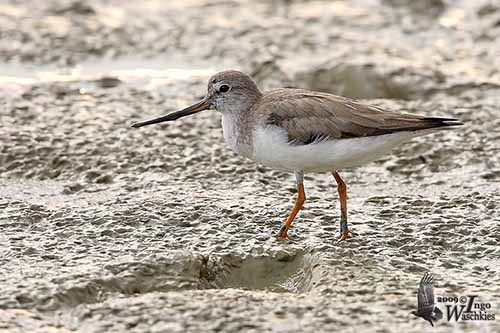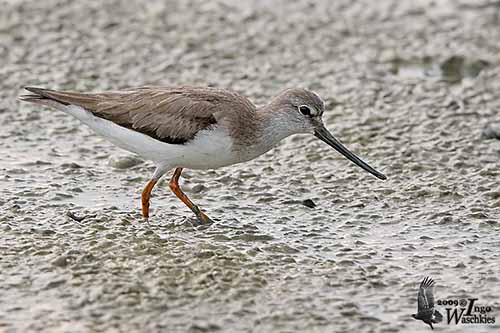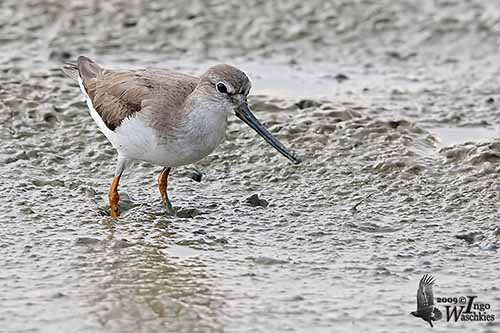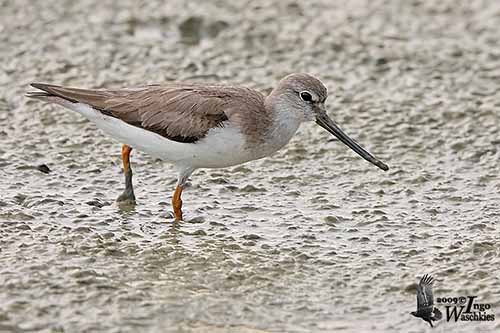
Fr: Chevalier bargette
Ang: Terek Sandpiper
All: Terekwasserläufer
Esp: Andarríos del Terek
Ita: Piro-piro terek
Nd: Terekruiter
Sd: Tereksnäppa
Photographer:
Ingo Waschkies
My bird pictures on Pbase
Text by Nicole Bouglouan
Sources:
HANDBOOK OF THE BIRDS OF THE WORLD Vol 3 by Josep del Hoyo-Andrew Elliott-Jordi Sargatal - Lynx Edicions - ISBN : 8487334202
SHOREBIRDS by Peter Hayman, John Marchant and Tony Prater – Christopher Helm – 1986 – ISBN: 0747014035
BIRDS OF THE MIDDLE EAST by R.F. Porter, S. Christensen, P Schiermacker-Ansen C.Helm - ISBN: 0713670169
THE HANDBOOK OF BIRD IDENTIFICATION FOR EUROPE AND THE WESTERN PALEARCTIC by Mark Beaman, Steve Madge - C. Helm - ISBN: 0713639601
Department of Sustainability, Environment, Water, Population and Communities
What Bird-The ultimate Bird Guide (Mitchell Waite)
Wikipedia, the free encyclopaedia
Birds in backyards (Birds Australia and Australian Museum)
Terek Sandpiper
Xenus cinereus
Charadriiformes Order – Scolopacidae Family
INTRODUCTION:
The Terek Sandpiper is the only member of the genus Xenus. Short-legs and long, upcurved bill make this bird very distinctive. Its foraging behaviour is more active than the other Scolopacidae, as it is frequently seen running about with the prey, in order to wash it before to swallow it.
This species is threatened by degradation and loss of the habitat, human pressure and pollution, but the population is currently stable.
The first individual was found in the Terek River on the NE edge of the Caucasus, giving the bird its English name.
DESCRIPTION OF THE BIRD:
Biometrics:
Length: 22-25 cm
Wingspan: 57-59 cm
Weight: 50-126 g
The adult in breeding plumage has grey-brown upperparts with narrow black streaks on feathers, more conspicuous on scapulars where they form long, blackish lines. Rump, uppertail-coverts and tail are usually paler grey than rest of upperparts. We can see whitish tips to feathers in fresh plumage.
On the upperwing, the coverts vary from grey-brown to blackish-brown, with broadly tipped white secondaries, forming a conspicuous trailing edge.
The underparts are white with grey wash on the breast, slightly darker and streaked with brown on the sides, almost forming breast patches. The underwing is white with dark centres to lesser coverts.
On the head, the lores are dark, and we can see a narrow dark line behind the eye.
The long-upcurved bill is blackish with dull orange area at base. The eyes are dark brown, surrounded by white eyering. Legs and partially webbed feet are bright orange to greenish-yellow.
The bill may vary in size and curving among individuals, but the females have slightly larger bill than males.

The non-breeding adult is duller and plainer, with pale edges to upperpart feathers and paler head.
The juvenile resembles breeding adult, but the upperparts are darker and browner with narrow buff fringes. Scapulars show less conspicuous black lines.
RANGE:
The Terek Sandpiper breeds from S Finland, NW Russia and Ukraine E through Siberia to Anadyr land. It breeds in boreal taiga area and extends N into subarctic tundra and S to steppe fringes.
Its wintering areas include SW, S and E Africa through Middle East, S Asia and Indonesia to Australia.
HABITAT:
The Terek Sandpiper nests on sandy or muddy river banks and islets, along wide marshy streams, also in wet meadows in taiga zone, in lowland valleys, often on floodplains with tall grasses and scrub willows.
It winters on open tidal sandbars and mudflats, brackish pools, riverbeds, estuaries, coastal lagoons, reefs, coastal marshes, and at inland lakes during migration.

CALLS AND SONGS: SOUNDS BY XENO-CANTO
The Terek Sandpiper’s flight call is a clear, fluty “tjiy-tjiy” or “dwitt-dwitt” softer than Common Redshank. We can also hear trilling “du-du-du-du-du… » and a softer « hu-hu-hu ». During the displays, it utters series of melodious whistled phrases “klueeu” or long musical “prerrr”. The alarm call is a sharp “tu-li”.
BEHAVIOUR IN THE WILD:
The Terek Sandpiper feeds primarily on adult and larvae midges, but it also takes seeds, other insects, small molluscs, crustaceans, spiders and annelid worms.
It feeds with very active movements and chases mobile preys on the surface of the water. But it also probes deeply with the long bill. It pecks at sand too and uses the sideway sweeping movements of avocets in shallow water.
It is frequently observed running with prey to the nearby water, in order to wash the food item before to swallow it.

They feed in groups of 5-25, but the birds are usually scattered. However, they roost communally, perched on branches in mangroves, or on partly submerged posts.
During the breeding season, the male performs aerial displays, but it also displays on the ground with fluttering wings and raised tail, while singing loudly. They are monogamous.
The Terek Sandpiper is migratory and moves S between July and October, and N in April-May. Numerous birds migrate along the coasts in the extreme E of the range.
A large part of the non-breeder birds remains on the wintering grounds all year.
This species has swift, direct flight with rapid wingbeats. The flight action is rapid and often low over water.
REPRODUCTION OF THIS SPECIES:
The breeding season takes place between May and July.
The Terek Sandpiper nests on the ground in open in low vegetation and close to the water. The eggs are laid in a scrape with a lining made with grass and debris.
The female lays 4 pale grey eggs with dark speckles. She does most of incubation during 23-24 days. At hatching, the chicks have greyish-brown down above with narrow dusky markings. The underparts are white. They fledge 2 weeks after hatching. Both parents tend the young.
This species produces a single brood per season.
PROTECTION / THREATS / STATUS:
The Terek Sandpiper is affected by increasing pollution, degradation of the habitat due to declining river flows, and human disturbances. However, the global population appears stable and is estimated at 160,000/1,200,000 individuals. But some population trends are still unknown.
But currently, the Terek Sandpiper is evaluated as Least Concern.
